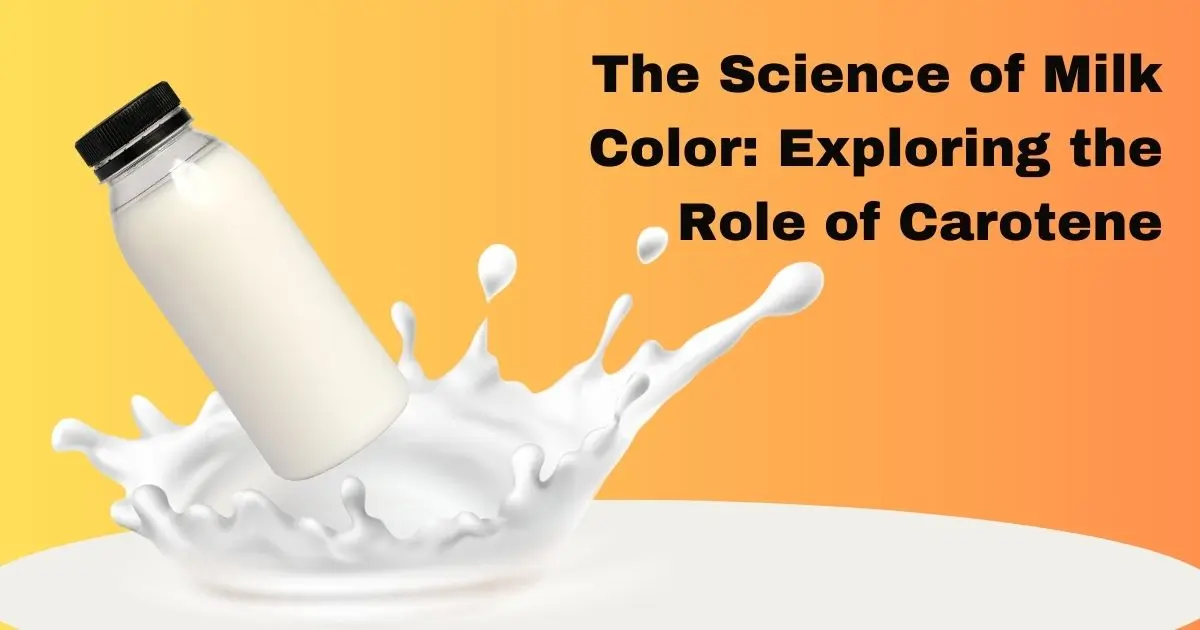Have you ever poured a glass of cow’s milk and noticed that it’s not always pure white but sometimes boasts a subtle yellow hue? If you’ve been curious about this phenomenon, you’re in the right place.
The answer lies in the captivating world of pigments, specifically carotene, and a range of other factors that contribute to the color of our beloved dairy staple.
Page Index
Carotene Role
Carotene is a photosynthetic pigment essential for the process of photosynthesis in plants. What makes carotene particularly intriguing is the fact that it contains no oxygen atoms.
So, how does it end up in cow’s milk? The answer is as simple as it is fascinating: cows consume carotene-rich plants like grass and flowers, and this pigment is carried over into the fat present in their milk.
Cow’s Milk Composition
Before we dive deeper into the role of carotene, let’s take a moment to understand the composition of cow’s milk. Approximately 87% of cow’s milk is water, while the remaining 13% comprises solids.
Among these solids, you’ll find various molecules that, interestingly, lack the ability to absorb color. These include protein casein, calcium complexes, and fats. However, it’s the presence of carotene in the milk fat that gives it that distinct yellow tint.
Beta Carotene
Beta carotene, the precursor of vitamin A, is not only a coloring pigment but also a nutritional powerhouse. Beyond enhancing the color of milk, beta-carotene plays a vital role in human nutrition.
In our bodies, beta carotene can be converted into vitamin A, which is essential for maintaining healthy vision and a robust immune system.
Factors Influencing Milk Color
The intensity of the yellow color in cow’s milk can vary. Several factors come into play, including the breed of the cow, its diet (especially the types of grass and flowers it consumes), the size of fat globules, and the overall fat percentage of the milk. Hence, minor fluctuations in these factors can lead to subtle differences in milk color.
Carotene Health Benefits
In the world of nutrition, the vibrant yellow hues found in milk, cream, butter, ghee, and other fat-rich dairy products can be attributed to a remarkable compound known as carotene.
This fat-soluble pigment not only adds a delightful color to these dairy staples but also brings forth a plethora of health benefits, acting as an antioxidant and a precursor to essential vitamin A.
In this article, we delve into the golden health advantages that carotene bestows upon us through our favorite dairy products.
The Golden Glow of Carotene
Carotene, a pigment widely distributed in nature, takes center stage in dairy products when it comes to their coloration. The distinct yellow and golden hues seen in cow milk, cream, butter, ghee, and more are all attributed to the presence of carotene.
This vibrant pigment adds a touch of visual appeal to these dairy items, making them not just delicious but also visually enticing.
Antioxidant Powerhouse
Beyond its role in making dairy products visually appealing, carotene serves as a potent antioxidant. Antioxidants are compounds that help protect our cells from oxidative stress and damage caused by free radicals.
Carotene, in particular, helps to neutralize these harmful free radicals, reducing the risk of chronic diseases and promoting overall well-being.
A Precursor to Vitamin A
One of the most significant health benefits of carotene is its role as a precursor to vitamin A. When we consume carotene-rich foods or dairy products, our bodies can convert this compound into vitamin A as needed.
Vitamin A is vital for maintaining healthy vision, supporting our immune system, and promoting proper growth and development.
Riboflavin: The Greenish-Yellow Wonder
While carotene takes the spotlight for its golden contributions to dairy products, it’s not alone in the world of pigments. Riboflavin, a greenish-yellow pigment, plays its part by giving whey, a byproduct of cheese-making, its characteristic color.
Beyond its role in coloration, riboflavin is an essential B vitamin that plays a crucial role in various bodily processes, including energy production and the metabolism of fats and drugs.
Incorporating Carotene-Rich Dairy Products into Your Diet
To reap the health benefits of carotene and riboflavin, consider incorporating carotene-rich dairy products like milk, cream, butter, and ghee into your daily diet. These products not only add flavor and texture to your meals but also provide essential nutrients to keep your body in top shape.
In conclusion, carotene, the golden pigment responsible for the vibrant hues in dairy products, is not just about appearances. It also serves as a formidable antioxidant and a precursor to vitamin A, promoting overall health.
Let’s not forget riboflavin, the greenish-yellow wonder found in whey, which adds its own nutritional value to our dairy consumption. So, the next time you enjoy a spoonful of butter or a glass of milk, savor not only the taste but also the health benefits these golden compounds provide.
Beyond its color, cow’s milk is celebrated for its nutritional value. It contains a substantial amount of sulfur, a crucial element for brain development. Additionally, cow’s milk is an excellent source of proteins and calcium, essential for overall health.
Exploring Additional Pigments
Carotene is not the only pigment found in cow’s milk. Riboflavin and xanthophylls are two other noteworthy compounds. Riboflavin, a vitamin essential for growth and good health, aids in the breakdown of carbohydrates, proteins, and fats to produce energy.
Xanthophylls, a class of oxygen-containing carotenoid pigments, are responsible for the yellow, orange, and red colors found in many flowers, fruits, and vegetables, including corn and peppers.
In conclusion, the subtle yellow hue in your glass of cow’s milk is a testament to the presence of carotene, a pigment naturally occurring in the plants that cows consume.
It’s not just about aesthetics; it’s a glimpse into the intricate processes of nature that contribute to the nutritional richness of this vital dietary staple. Carotene, along with other pigments, doesn’t just add color but also imparts valuable nutrients to the milk we enjoy every day.
So, the next time you savor a glass of cow’s milk, savor the golden secret hidden within – a tribute to the captivating interplay of nature’s compounds that make this liquid gold so nourishing.
Note: Carotenoid pigments, including carotene, are responsible for the yellow color of cow’s milk. They can also be found in various fruits, vegetables, and fungi, contributing to the vibrant hues of the natural world.


